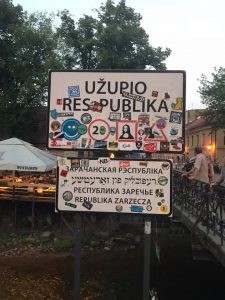Rainbow crosswalk in the front of the Lithuanian Gay League’s office (Vilnius, Lithuania)
By Dante Rossi
Note: Using an Undergraduate Summer Scholarship (USS) and a Travel Grant from the Havighurst Center, Miami student Dante Rossi conducted research on the LGBT+ communities in Baltic Cities. What follows is a short summary of his larger research paper completed for the USS project.
This past summer, I had the opportunity of traveling to Eastern Europe to conduct research on homosexuality and coming out stories in Kaunas (Lithuania), Vilnius (Lithuania), and Riga (Latvia). I had conducted a similar study in Oxford, Ohio on college-aged homosexual men and argued that among these individuals, coming out stories were a ritualized practice that served as a rite of passage into the LGBT+ community.
Prior to conducting field-work in the Baltics, I began my studies of Eastern Europe and Post-Soviet nations in Dr. Neringa Klumbyte’s course sponsored by the Havighurst Center for Russian and Post-Soviet Studies, as well as a cinema class with films from the region. After receiving the Undergraduate Summer Scholars grant, I continued studying Post-Soviet nations, primarily focusing on the histories, policies, accessions into the European Union, and human rights in Lithuania and Latvia.
Once I finally reached the Baltic cities, I interviewed 9 individuals (ages 18-52) on their experiences as homosexuals in the region. Questions ranged from familial history to current political rhetoric being used to describe same-sex relations in the countries, ultimately attempting to try and better understand and contextualize their coming out processes. However, unlike the coming out stories in Oxford, the narratives of gay individuals in the three Eastern European cities varied greatly. Some individuals did not have coming out stories; they had never disclosed their sexuality to friends, colleagues, or family members. Other participants stated that while their family or friends knew, there was never a ritualized “coming out” process; instead it was just a topic that was brought up in conversation. Similarly, among some individuals, their friends and colleagues found out about the individual’s sexual orientation through media or news broadcastings, rather than from the participant themselves.
Ultimately, I argued that unlike the aforementioned coming out stories from Oxford, Ohio, these stories (if any) in Riga, Vilnius, and Kaunas did not function as a rite of passage for gay men into a community, primarily attributed to the taboo nature of sexuality during the USSR and its lingering effects, as well as the absence of a large LGBT community or sexuality-based support system. Additionally, I argued that in order to understand the absence of a large LGBT community in the region, as well as the reasons why coming out stories varied from Ohio collegiate gay men, it is imperative to view both of these facets of homosexual life in context with the history of Eastern Europe related to gender and hierarchical structures, as well as the accessions of Lithuania and Latvia into the European Union.




